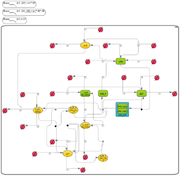Difference between revisions of "Orthogonal layout"
From BioUML platform
Tagir Valeev (Talk | contribs) (+image) |
Tagir Valeev (Talk | contribs) m (+stub message) |
||
| (One intermediate revision by one user not shown) | |||
| Line 1: | Line 1: | ||
| − | {{ | + | {{Layout algorithm|ru.biosoft.graph.GreedyLayouter}} |
| − | + | {{stub|algorithm details and references}} | |
| − | + | ||
Orthogonal layout methods, which allow the edges of the graph to run horizontally or vertically, parallel to the coordinate axes of the layout. They typically involve a multiphase approach in which an input graph is planarized by replacing crossing points by vertices, a topological embedding of the planarized graph is found, edge orientations are chosen to minimize bends, vertices are placed consistently with these orientations, and finally a layout compaction stage reduces the area of the drawing. | Orthogonal layout methods, which allow the edges of the graph to run horizontally or vertically, parallel to the coordinate axes of the layout. They typically involve a multiphase approach in which an input graph is planarized by replacing crossing points by vertices, a topological embedding of the planarized graph is found, edge orientations are chosen to minimize bends, vertices are placed consistently with these orientations, and finally a layout compaction stage reduces the area of the drawing. | ||
==See also== | ==See also== | ||
| − | * [[ | + | * [[Diagram document]] |
| − | + | ||
| − | + | ||
Latest revision as of 13:38, 2 July 2013
- Title
- Orthogonal layout
- Class
GreedyLayouter
| This page or section is a stub. Please add algorithm details and references here! |
Orthogonal layout methods, which allow the edges of the graph to run horizontally or vertically, parallel to the coordinate axes of the layout. They typically involve a multiphase approach in which an input graph is planarized by replacing crossing points by vertices, a topological embedding of the planarized graph is found, edge orientations are chosen to minimize bends, vertices are placed consistently with these orientations, and finally a layout compaction stage reduces the area of the drawing.
